Miele S 318i, S 300i Operating instructions
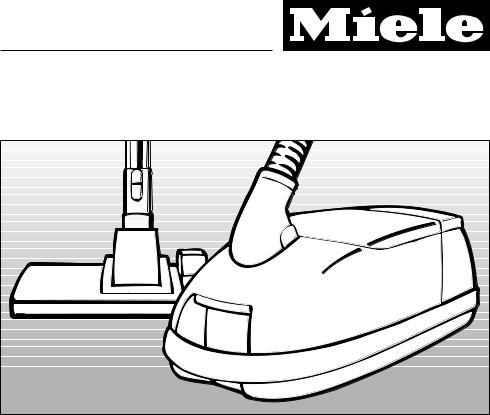
Operating instructions
Vacuum cleaners |
S 300i - S 318i |
These operating instructions apply to standard models S 300i - S 318i as well as to other S 300 series models which
are distinguished by names rather than model numbers.
WO
M.-Nr. 05 756 220

Contents
Caring for the environment . . . . . . . . . . . . . . . . . . . . . . . . . . . . . . . . . . . . . . . . . . 3
Description of the appliance . . . . . . . . . . . . . . . . . . . . . . . . . . . . . . . . . . . . . . . . . 4
Warning and Safety instructions . . . . . . . . . . . . . . . . . . . . . . . . . . . . . . . . . . . . . 6
Preparing for use . . . . . . . . . . . . . . . . . . . . . . . . . . . . . . . . . . . . . . . . . . . . . . . . . . 9
Accessories supplied . . . . . . . . . . . . . . . . . . . . . . . . . . . . . . . . . . . . . . . . . . . . . 12
Using the accessories . . . . . . . . . . . . . . . . . . . . . . . . . . . . . . . . . . . . . . . . . . . . . 13 Crevice nozzle . . . . . . . . . . . . . . . . . . . . . . . . . . . . . . . . . . . . . . . . . . . . . . . . . . . . 13 Crevice nozzle extension . . . . . . . . . . . . . . . . . . . . . . . . . . . . . . . . . . . . . . . . . . . . 13 Dusting brush . . . . . . . . . . . . . . . . . . . . . . . . . . . . . . . . . . . . . . . . . . . . . . . . . . . . 13 Upholstery nozzle . . . . . . . . . . . . . . . . . . . . . . . . . . . . . . . . . . . . . . . . . . . . . . . . . 14 Blower connection socket . . . . . . . . . . . . . . . . . . . . . . . . . . . . . . . . . . . . . . . . . . . 14
Operation . . . . . . . . . . . . . . . . . . . . . . . . . . . . . . . . . . . . . . . . . . . . . . . . . . . . . . . 16 Unwinding and rewinding the mains cable . . . . . . . . . . . . . . . . . . . . . . . . . . . . . . 16 Switching on and off . . . . . . . . . . . . . . . . . . . . . . . . . . . . . . . . . . . . . . . . . . . . . . . 17 Regulating the suction . . . . . . . . . . . . . . . . . . . . . . . . . . . . . . . . . . . . . . . . . . . . . . 18 Opening the air inlet valve . . . . . . . . . . . . . . . . . . . . . . . . . . . . . . . . . . . . . . . . . . . 18 Park system . . . . . . . . . . . . . . . . . . . . . . . . . . . . . . . . . . . . . . . . . . . . . . . . . . . . . . 19 Transportation and storage . . . . . . . . . . . . . . . . . . . . . . . . . . . . . . . . . . . . . . . . . . 19 Dustbag change indicator . . . . . . . . . . . . . . . . . . . . . . . . . . . . . . . . . . . . . . . . . . . 20
Maintenance and care . . . . . . . . . . . . . . . . . . . . . . . . . . . . . . . . . . . . . . . . . . . . . 21 When should the dustbag and filters be changed? . . . . . . . . . . . . . . . . . . . . . . . 21 Purchasing new dustbags and filters . . . . . . . . . . . . . . . . . . . . . . . . . . . . . . . . . . 23 Ordering the correct dustbags and filters . . . . . . . . . . . . . . . . . . . . . . . . . . . . . . . 23 To replace the dustbag and filters . . . . . . . . . . . . . . . . . . . . . . . . . . . . . . . . . . . . . 24 Changing the thread lifters . . . . . . . . . . . . . . . . . . . . . . . . . . . . . . . . . . . . . . . . . . 26
Cleaning and care . . . . . . . . . . . . . . . . . . . . . . . . . . . . . . . . . . . . . . . . . . . . . . . . 27
Problem solving guide. . . . . . . . . . . . . . . . . . . . . . . . . . . . . . . . . . . . . . . . . . . . . 28
After sales service . . . . . . . . . . . . . . . . . . . . . . . . . . . . . . . . . . . . . . . . . . . . . . . . 29
Optional accessories. . . . . . . . . . . . . . . . . . . . . . . . . . . . . . . . . . . . . . . . . . . . . . 30
Electrical connection. . . . . . . . . . . . . . . . . . . . . . . . . . . . . . . . . . . . . . . . . . . . . . 35
2

Caring for the environment
Disposal of packing material
The transport and protective packing material has been selected from materials which are environmentally friendly for disposal and can normally be recycled.
Ensure that any plastic wrappings, bags etc. are disposed of safely and kept out of the reach of babies and young children. Danger of suffocation!
Rather than just throwing these materials away, please ensure they are offered for recycling.
Disposal of your old appliance
Old appliances may contain materials which can be reclaimed or recycled. Please contact your dealer, your local waste collection centre or scrap merchant about potential recycling schemes.
Before disposing of an old appliance first make it unusable. Disconnect it from the mains, cut the cable off the appliance as close to the cleaner as possible and cut the plug off. The plug cut from the cable should be rendered useless and then disposed of and on no account be inserted into any socket elsewhere in the house (electric shock hazard).
Make appropriate arrangements for its safe disposal and make sure that the appliance presents no danger to children while being stored for disposal.
Disposing of the dustbag and filters
These are made from environmentally friendly materials and can be disposed of with the normal household waste. The dustbag should only be disposed of in this way if it has been used exclusively for general household dust.
3
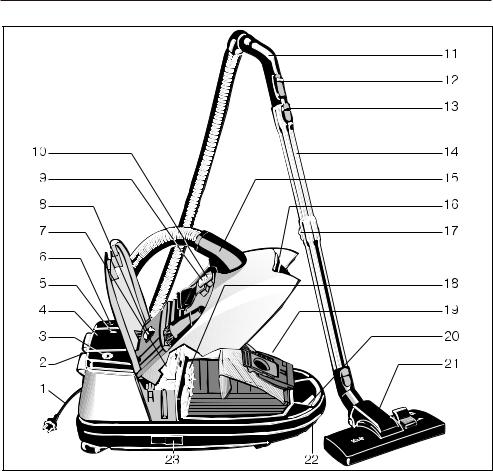
Description of the appliance
4

Description of the appliance
1Mains cable with plug (plug varies depending on country)
2Park System
3Cable rewind
4Suction power selector *
5Overheating warning light *
6On / Off switch
7Exhaust filter *
8Blower socket
9Dustbag change indicator
10Release button for the accessories compartment
11Hand piece
12Air inlet valve
13Locking button
14Suction tube *
15Elbow
16Dust compartment lid catch
17Slide control *
18Dust compartment filter (for motor protection)
19Dustbag
20Socket for Electrobrush*
21Floorhead
22Carrying handle
23Parking attachment
The illustration shows the maximum number of features available on these Miele vacuum cleaners.
Those features marked * depend on the model and may vary or not be available on your model.
Some models are supplied with a Miele Electrobrush or Turbobrush as standard (not illustrated). These brushes are supplied with their own operating instructions.
5
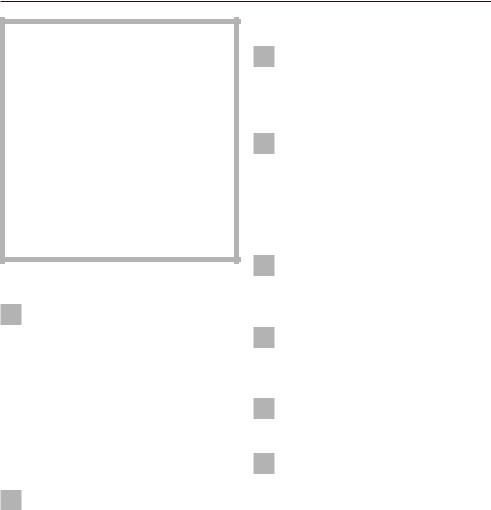
Warning and Safety instructions
This appliance meets statutory safety requirements. Inappropriate use can however lead to personal injury and damage to property. Read the operating instructions carefully before starting to use this appliance. They give important information on the safety, operation and care of the appliance. This way you will prevent the risk of accident or damage to the appliance. Please keep these operating instructions in a safe place for reference, and pass them on to any future users.
Correct usage
This vacuum cleaner must only be used in a domestic household situation to vacuum dry floor surfaces. Do
not use on people or animals.
Any other usage is at the owner’s risk and could be dangerous.
The manufacturer cannot be held liable for damage resulting from improper or incorrect use of the appliance.
Children
Do not let small children play with the appliance or operate it. Please supervise its use by older children and
the elderly or infirm.
Before using for the first time
A damaged vacuum cleaner can be dangerous. Check the packag-
ing, the vacuum cleaner and accessories for any signs of damage. Do not use a damaged appliance.
Ensure that the connection data on the data plate (voltage and fre-
quency) match the mains electricity supply. It is essential that they match to avoid damage to the appliance.
Daily use
It is important to switch the vacuum cleaner off before changing over
accessories and floor heads, especially a Turboor Electrobrush.
To avoid the risk of damage, do not use the vacuum cleaner without the
dustbag, dust compartment filter and exhaust filter in place.
If a dustbag is not inserted, the dust compartment cover does not
normally close. Do not force it.
There is a metal inlay underneath the handle, which is designed to protect the user from electrostatic dis-
charges. Please make sure that you keep your hand in constant contact with this metal strip during vacuuming. This way any build-up of electrostatic charge will be rendered ineffective.
6

Warning and Safety instructions
Do not vacuum up liquids or damp dirt. This will cause major faults
and could seriously impair the functioning and electrical safety of the appliance. Wait until any freshly cleaned or shampooed carpets or floor coverings are completely dry before attempting to vacuum.
Do not vacuum up anything which has been burning or is still glowing e.g. cigarettes, ashes or coal, whether
glowing or apparently extinguished. The cleaner might catch fire.
Do not vacuum up toner dust. Toner, such as that used in printers
and photocopiers can conduct electricity. The filter system in the vacuum cleaner may not filter it completely and so the toner could be blown back into the atmosphere by the fan.
Do not vacuum up any inflammable or combustible liquids or gases
and do not vacuum in areas where such substances are stored. The cleaner might explode.
Do not vacuum up items which are heavy, hard or have sharp edges.
They could cause a blockage and damage the appliance.
Floor attachments, accessories and tubes must not be used at head level to avoid the risk of injury,
e.g. to eyes and ears.
Do not pull or carry the appliance by the cable. When disconnecting from the mains socket pull by the plug
not by the cable.
-Keep the cable away from sharp edges and do not let it be squashed, for example, under a door.
-Avoid running the vacuum cleaner over the cable.
A damaged cable, plug or socket is a safety hazard. The appliance must not be used if any of these have suffered damage.
Monitor the change dustbag indicator and change the dustbag if
necessary. Check the exhaust and dust compartment filters at the same time and change them too if necessary. A full bag or blocked filter will reduce the suction power of the cleaner. A temperature limiter switches the vacuum cleaner off automatically if it gets too hot, see section "Problem solving guide".
Do not use aroma capsules if your cleaner is fitted with an ACTIVE
HEPA filter or an ACTIVE air clean filter. The active charcoal layer in the filter will absorb the aroma from the capsules rendering them ineffective.
7
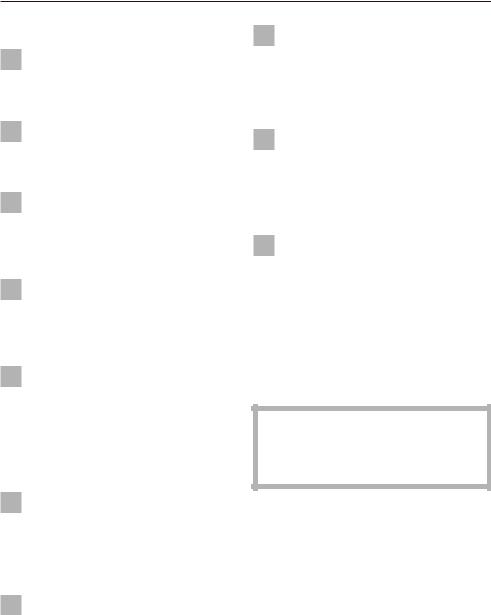
Warning and Safety instructions
Using accessories
The socket on the vacuum cleaner (depending on model) must only
be used for the Miele Electrobrush specified for use with this appliance.
To avoid the risk of injury when vacuuming with a Miele Electroor
Turbobrush do not touch the rotating roller brush.
It is not advisable to vacuum directly with the handle, i.e. without
an accessory attached as the rim could get damaged and you could hurt yourself on sharp edges. Danger of injury.
Miele vacuum cleaner bags are disposable and intended to be
used only once. Do not attempt to re-use. Blocked pores reduce the efficiency of the cleaner.
Use only genuine Miele dustbags, filters and accessories. This ensure
optimum performance of the vacuum cleaner throughout its life.
Cleaning, maintenance and repairs
Always disconnect the vacuum cleaner from the mains supply for
maintenance work and for cleaning. Switch off at the wall socket and remove the plug. Pull on the plug and not the cable.
Do not let the vacuum cleaner get wet. Clean only with a dry cloth or slightly damp cloth when disconnected from the mains supply. If moisture gets into the appliance there is the risk of an
electric shock.
Repairs may only be carried out by a suitably qualified and competent person in accordance with national and
local safety regulations. Repairs and other work by unqualified persons could be dangerous.
If the cable is damaged it should be replaced together with a complete cable rewind by a Miele service
technician.
Disposing of an old appliance
When disposing of an old appliance cut the cable off the appli-
ance as close to the cleaner as possible and cut the plug off. The plug cut from the cord should be rendered useless and then disposed of and on no account be inserted into any socket elsewhere in the house (electric shock hazard). See section "Disposal of your old appliance" earlier in this booklet for further advice.
The manufacturer cannot be held liable for damage caused by non-com- pliance with these Warning and Safety instructions.
8
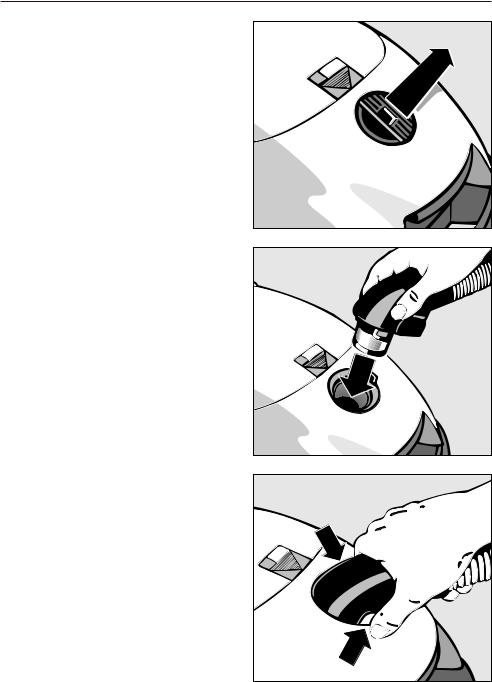
Preparing for use
Attaching the suction hose
^ Open the dust compartment shutter (depending on model).
The dust compartment shutter is designed for hygienic handling and prevents dust and odours escaping. If you remove the suction hose from the vacuum cleaner for storage purposes close the dust compartment shutter before putting the cleaner away (e.g. in a cupboard).
^ Insert the elbow into the suction socket.
To remove the suction hose from the cleaner
^ Press the release buttons at the side of the elbow and lift the hose from the socket.
9
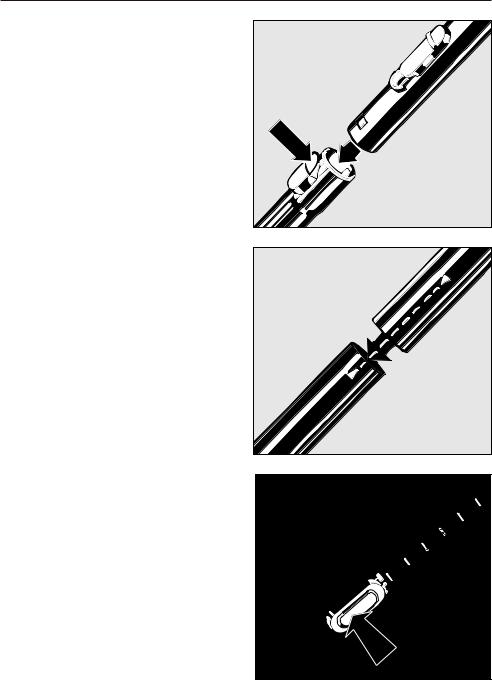
Preparing for use
Connecting the suction hose and the suction tube
^Fit the hand piece of the suction hose into the suction tube and turn clockwise or anti-clockwise until they lock together with a click.
^To release the hand piece from the suction tube press the locking button (see arrow) and pull the hand piece away from the suction tube.
Connecting the suction tube sections
(depending on model)
Both sections of the suction tube have directional arrows marked on them. The tips of the these arrows should point towards each when you join the sections together.
Adjusting the telescopic suction tube
(depending on model)
One part of the telescopic tube is packed inside the other and can be adjusted to suit your height for comfortable vacuum cleaning.
^Press the telescopic tube release button (see arrow) to release the tubes and adjust to the required height.
10

Preparing for use
Attaching the floorhead
^Push the suction tube into the floorhead and turn it clockwise or anticlockwise until it clicks into position.
^To release the floorhead from the suction tube, press the locking button (see arrow) and pull the suction tube away from the floorhead.
The floorhead can be used for all normal cleaning of carpets and rugs. It can also be used with the brush protruding to vacuum hard flooring which is not susceptible to scratching. For hard flooring, such as stone and floors which are susceptible to scratching, e.g. parquet, we recommend using one of the special Miele floor brushes (see "Optional accessories").
It is also important to observe the flooring manufacturer’s cleaning and care instructions.
Vacuum carpets and rugs with the brush retracted:
^Press the foot switch to the g position.
Clean hard flooring which is not susceptible to scratching with the brush protruding:
^Press the foot switch to the h position.
Electrobrush / Turbobrush
Some models may be supplied as standard with an Electrobrush or a Turbobrush in addition to the normal floorhead (see "Optional accessories").
Please refer to the separate operating instructions supplied with these brushes for instructions on use and maintenance.
11
